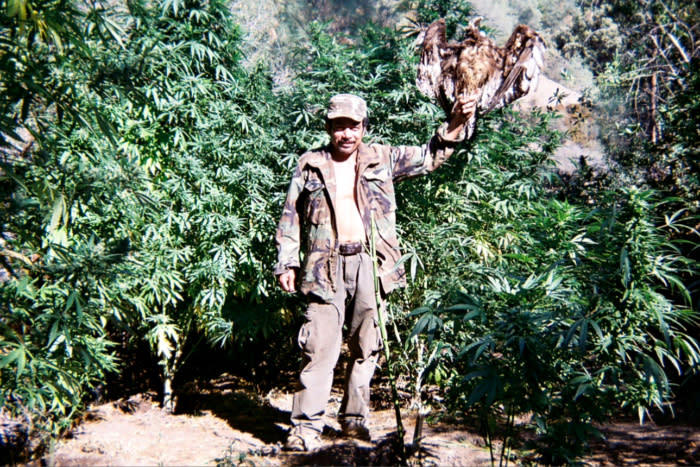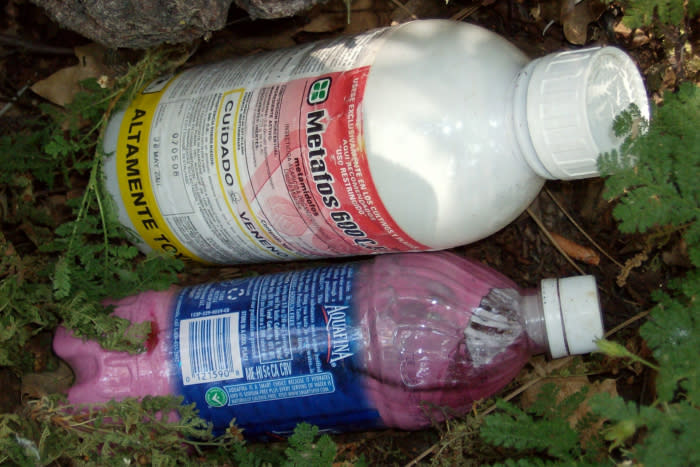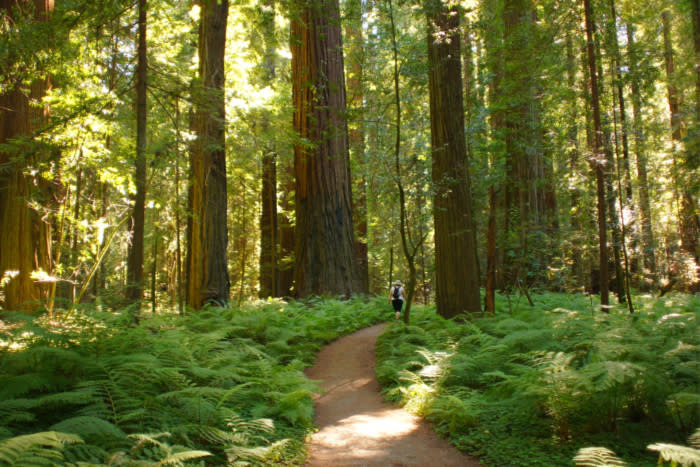Cartel Crops Infest Public Lands, and They’re as Dangerous as You Think

There are a lot of reasons why you don’t want to stumble upon an illegal cannabis grow operation, according to John Nores, a retired lieutenant with the California Department of Fish and Wildlife (CDFW).
Poisonous fumes could be in the air. You could get shot. You could even be mauled by trained attack dogs or get caught in booby traps.
And in reality, the chances of you happening onto such an operation are probably higher than you think — especially if you spend much time exploring public lands like national and state forests and parks.
Nores helped found CDFW’s Marijuana Enforcement Team (MET) to find and break up these cannabis grows hidden deep in America’s public lands. He told GearJunkie that almost a quarter of the cannabis sold on the U.S. black market is grown domestically, on public land. These grow operations are hidden in remote areas in the backcountry, where outdoor enthusiasts recreate. And there are thousands of them out there.
“It is mind-blowing how dangerous these groups are, both on public and private land,” Nores told GearJunkie. He claims he’s had firefights with cartel members, been exposed to illegal neurotoxic chemicals, and had to medevac partners who’ve been seriously injured while breaking these operations up.
“You’ve got to realize you’re dealing with very violent people. They will hurt you or kill you at the drop of a hat if they need to. We’ve seen it.”
Beyond the immediate threat to visitors are insidious, longer-term dangers. These groups illegally divert water, pollute with banned pesticides and fertilizers, poach animals, and sometimes even intimidate locals.
Mourad Gabriel is the Trespass Cultivation Ecology, Safety and Reclamation Program Manager for the U.S. Forest Service Law Enforcement and Investigations branch. He collects data on the environmental impacts these sites leave behind. In his career so far, he told GearJunkie he’s visited over 500 trespass grows. On average, he says they’ll have between 2,000 and 5,000 plants growing, sometimes much more.
“Nobody wants to go camping, hiking, hunting, fishing, or biking and stumble across [a trespass grow],” Gabriel said. But in California alone, “we have over 3,000 cultivation sites on federal public lands.”
And that’s just what they know of. While authorities use satellite imagery to find these grows on public lands, it’s often hikers, anglers, hunters, and backpackers who wander across them.
Nores’ book, “Hidden War,” is currently in its second printing. He no longer lives in California but is still very involved with public speaking and with Fish and Wildlife MET training. Last October, he spoke to Congress in Washington, D.C., to update lawmakers on how this issue is evolving.
Marijuana Enforcement Team: Cannabis on Public Land
Nores has always been passionate about the outdoors. When he joined the CDFW, he thought he’d be checking hunting licenses and keeping tabs on fish populations. Instead, he co-founded a tactical unit dedicated to hunting California’s proliferating illegal trespass cannabis grows — on National Forests, BLM, and other public lands.
The Marijuana Enforcement Team was the first of its kind in the country. Nores had seen firsthand how dangerous these sites were and their severe and irreversible impacts on the environment.
EPA-banned toxic pesticides and fertilizers were poisoning streams. Growers were illegally diverting water. Garbage and human waste littered the areas. And they poached protected animals.
He saw a need for specially trained officers to pursue these multiplying illegal operations like a SWAT team for the great outdoors. So he helped found MET and spent the rest of his career fighting what he’d later call a “Hidden War.”
What Does an Illegal Grow Op Look Like?
“More and more states are having a problem [and] there’s more threats to people recreating in the outdoors,” Nores told GearJunkie. So, how can you recognize an illegal grow operation if you see one?
Nores said it’s pretty obvious — even if you can’t see the cannabis plants.
“You’re going to see a real messy, messy operation,” he said. Water trucks will occupy the property. A doughboy pool, or some other reservoir will have pipes and water lines feeding into hoop houses or outdoor growing areas.
“Then you’ll sometimes see 55-gallon drums, unmarked, that are usually full of some very toxic chemical. And everything from gasoline tanks to big generators, because they need power.”
People Are the Biggest Threat
First and foremost, Nores said that the people working at an illegal trespass grow are the biggest threat to outdoor enthusiasts.
“People that end up stumbling upon those groups, if they’re interdicted, they sometimes disappear,” Nores said, referencing the Netflix documentary series Murder Mountain. “California has had a lot of missing persons.”
Gabriel backed that up. He said that armed cultivators might suspect that a hunter, angler, hiker, or backpacker is there to steal their crops or report their trespass grow to the authorities. He said sometimes these are million-plus-dollar operations, and the people protecting them can’t afford to jeopardize that.
This issue isn’t limited to the Golden State, either. In 2018, federal agents removed over 71,000 plants spread over 38 acres in the San Isabel National Forest in Colorado. Also in Colorado, in 2020, law enforcement busted a 16,000-plant grow op near Rifle that spread over a mixture of private and public land.
Nores said Michigan, Oklahoma, Maine, and Oregon have all started seeing more instances of this as well.
“The people running the grow are legitimately part of the illegal enterprise and often using human trafficked, indentured servitude individuals to work on it,” Nores said.
Environmental Toxins, Booby Traps, Attack Dogs
By their nature, illegal cannabis grows on public land don’t follow EPA guidelines. They often use extremely dangerous, highly toxic pesticides and fertilizers that wreak havoc on the environment. Some of them, like carbofuran insecticides, are neurotoxic to humans.
“A couple tablespoons of that will kill a mile of creek,” Nores said. “If you see signs of a lot of dead things in any water source, do not try to purify that water.”
A typical backpacking or outdoor water filter will not keep those substances out of your water.
Gabriel added that, in his experience, illegal grow sites typically have gallons and gallons of these toxic pesticides present. Rarely are those stored properly.
On top of all that, some grow operations Nores broke up on public land also had Vietnam-era pungee pits and other booby traps. And more often, the cartels have started to bring in attack dogs to protect their areas as well, he said.
What to Do If You Find an Illegal Grow on Public Land
Gabriel didn’t mince his words when asked what someone should do if they find an illegal grow on public land. Whether it’s an active illegal grow site — or one that’s been abandoned — he advises to keep your distance and get out of there as fast as possible. Don’t touch things, don’t take pictures, and don’t dilly-dally.
But he added some good advice on how to get out of there.
“If you see a grow and the wind is at your face, you need to get the wind at your back,” Nores said. Some illegal grows use smoke aromas to apply neurotoxic pesticides, which can be lethal to breathe even from a distance.
When you feel you’re far enough away, mark the area with a GPS pin on your map, or make a mental note of where you are. Then, follow your route back out.
“You’re going to want to get out the way you came in safely … don’t run and scatter, use some field crafts, sneak out a little bit,” Nores said. “Then, you’re going to want to report it when you get out of there.”
He recommends contacting the county sheriffs or law enforcement branch of USFS to report the cannabis grow. The more detailed you can be concerning where you saw the grow, and what you saw, the better.
Raid & Reclamation
After a cannabis grow operation on public land has been reported, a team like the MET raids it. They break it up and make arrests. Then, cleanup and reclamation begins. This is the most important part of the process because, as Gabriel points out, these sites are still extremely dangerous even when inactive. The toxic chemicals are often still present, leaking into streams and contaminating ecosystems.
Gabriel adds that reclamation prevents these grow sites from reestablishing. If they only clean up a site partially, the chances that the cartel will return and start over are much higher.
“If [we] disrupt the site at a 50 or 60% level, there is a 30 to 45% chance they will re-establish that site,” he said. “You have to remove a site between 95 to 98%, and then you’re going to have less than 1% reestablishment rate.“
The ‘Green Line’
Nores doesn’t want to deter people from enjoying nature and public lands; he wants to prepare them.
“Don’t don’t be paranoid. Don’t be afraid to go in the woods. Knowledge is power. Have the tools to deal with the problem. You need to just be on the lookout and have some situational awareness,” Nores said.
Plus, the public using public lands multiplies the eyes and ears of Forest Service rangers and Fish and Wildlife wardens.
“There’s just thousands of hikers, hunters, anglers, outdoor recreational backpackers playing in public lands, and we’re all part of the same Green Line,” Nores said.
The second printing of Nores’ book, “Hidden War,” is available on Amazon. Follow him on Instagram, @johnnores.
The post Cartel Crops Infest Public Lands, and They’re as Dangerous as You Think appeared first on GearJunkie.







